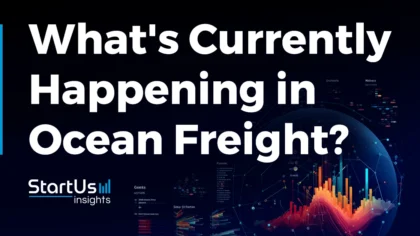Did you know that shipping prices can increase fourfold overnight due to a single stoppage in a major marine freight route? Given the state of disarray in the industry due to the Red Sea battle, many businesses are facing a harsh reality in the current quarter. Professionals and corporations alike must comprehend these advances because they have far-reaching effects. From the latest industry events to important partnerships in the field, this quarterly sea freight news brief for January, February, and March 2024 provides a comprehensive snapshot of what is happening in the global ocean freight industry today.
Key Takeaways
- Global Trade Impact: The conflict in the Red Sea highlights the vulnerability of global trade routes to geopolitical tensions, exacerbating the challenges faced by exporters like Han Changming.
- Multimodal Freight Solutions: Companies like Enpal, Forto, and Maersk are pioneering multimodal freight solutions, offering innovative approaches to demurrage management, emissions reduction, and service diversification.
- Alternative Transport Demand: The escalating situation in the Red Sea is inadvertently boosting demand for alternative transport modes, such as rail and air cargo, as exporters seek viable routes to circumvent the crisis.
- Technological Innovations: Technological advances are playing a crucial role in reshaping the sea freight industry, with platforms like Forto simplifying demurrage processes and partnerships focusing on sustainable multimodal shipping.
- Strategic Business Recommendations: To navigate through these turbulent times, businesses are advised to diversify transportation methods, invest in tech-driven freight management solutions, and remain vigilant to global events.
- Future Outlook: The immediate challenge for companies is to adapt to rate volatility and explore flexible solutions. In the mid-term, integrating technology and diversifying routes will be key to resilience, while long-term sustainability and adaptability will ensure industry survival.
How We Researched and Where this Data is from
This article is fueled by insights from the StartUs Insights Discovery Platform, a comprehensive resource tracking more than 4.7 million startups and scaleups globally. Our platform monitors over 20,000 technology trends, covering 100K feeds across various industries.
For this piece, we’ve leveraged the platform to analyze 1000 of the most recent and impactful news evolving around ocean freighting. Further, our platform allows you to dig deeper into ocean freights and investigate other topics based on your preferences. Interested in exploring the latest news, developments, innovations, and breakthroughs relevant to your business? Book a demo with us today and discover the full potential of our platform for your strategic needs.
What’s Currently Happening in Ocean Freight?
Global Trade Creates Ripples in the Red Sea
With the Red Sea war at its center, the sea freight business is today navigating through a storm of geopolitical tensions. In addition to driving up freight costs, this instability is making Chinese exporters’ existence more precarious. Among the several individuals impacted by the abrupt increase in expenses is Han Changming, a well-known businessman in China. This volatility is reflected in the dry bulk index of the Baltic Exchange, which had its worst week since 2008. There’s no denying the industry’s unpredictable nature as capesize rates rise and others struggle.
Multimodal Approaches to Ocean Freight: The Emerging Hope
Innovation in logistics is a lifeline in the face of these disruptions. Leading the way with solutions for demurrage management and reducing emissions, respectively, are companies like Enpal and Forto. In the meantime, DACHSER’s growth into the Nordic region and Röhlig Logistics’ entry into Canada are strategic moves to diversify routes and services. With a 40% reduction in emissions, Maersk’s methanol-enabled vessel and Kerry Logistics Network’s sea-air solutions also herald a new era of environmentally responsible transportation.
The Price of War and the Lookout for Remedies
The Red Sea predicament presents a “pleasant headache” for the rail sector, as demand for alternate routes rises. But as the crisis threatens to collapse their companies, the pressure on China’s exporters is growing. Despite a 5% drop in worldwide volume in 2023, air cargo may increase as businesses search for workable substitutes. The industry’s shift to these multimodal products, thus, shows how important sea/air services are strategically today more than ever.
Trends in Technology Are Changing the Industry
Technological advances are transforming the sea freight business and testing its resiliency. For instance, Forto’s platform simplifies the laborious demurrage procedure. Partnerships such as the one between DHL and Schneider Electric demonstrate a dedication to environmentally responsible multimodal shipping models. These strategic collaborations also demonstrate that progress and environmental responsibility can coexist.
Managing During the Storm: Business Suggestions
It is recommended that businesses vary their modes of transportation in order to mitigate the risk of regional conflicts and interruptions. It is also necessary to invest in technological solutions for freight management that promote sustainability and efficiency. In order for businesses to stay viable, they need to maintain a close watch on world events that affect shipping routes and quickly modify their tactics.
The Path Ahead
In the near future, companies need to find flexible solutions and prepare for ongoing fluctuations in freight rates. To increase resilience, mid-term initiatives should concentrate on route variety and technology adoption. The industry’s resilience and sustainability will be crucial in the long term for surviving not just this storm but many more to come.
We’ve examined the most recent advancements in maritime freight as part of this quarterly series. It’s evident that although the sector faces enormous obstacles, the winds of change are also bringing both innovation and opportunity for those prepared to modify their course.

Staying informed is key to navigating its complexities and capitalizing on opportunities in the ocean freight sector. To keep your business ahead of the curve, use our platform to find recent developments and technologies in ocean freighting. Discovery Platform provides a condensed yet thorough overview of the latest trends and advancements for guiding your investment decisions and identifying effective collaboration opportunities.








